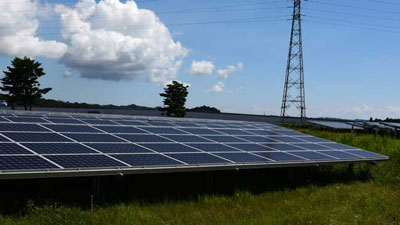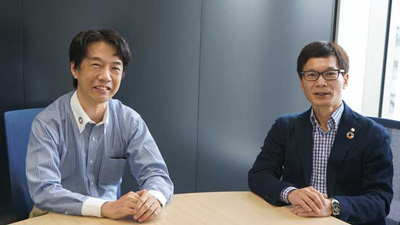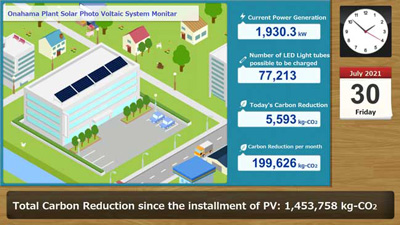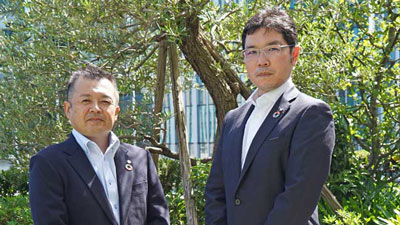Striving to be a trailblazer in climate action in Japan
The Daiichi Sankyo group of companies (Daiichi Sankyo Group) has been a trailblazer in corporate climate action in Japan: In the 4th Mid-term Environmental Management Policy for FY2016-2020, we set a long-term target for CO2 reduction (37.5% reduction by FY2030 from FY2015 baseline) aligned to the 2°C target of the Paris Agreement* based on the approach of the Science Based Targets initiatives (SBTi), an international initiative that encourages businesses to set science-based CO2 reduction targets aligned with the Paris Agreement goal of limiting global warming to well below 2°C.
Our target was approved by SBTi, making Daiichi Sankyo Group the second Japanese company to receive this approval. Central to our efforts are energy efficiency improvement and renewable energy adoption. We are adopting renewable energy across the Daiichi Sankyo Group, in line with the availability of renewables in each country and region.
* The Paris Agreement (French: Accord de Paris), often referred to as the Paris Accords or the Paris Climate Accords, is an international treaty on climate change, adopted in 2015. It covers climate change mitigation, adaptation, and finance.

Solar PV panels installed at Daiichi Sankyo Chemical Pharma's
On December 1, 2020, Daiichi Sankyo began operating a 3.3-MW solar photovoltaic (PV) power generator at Daiichi Sankyo Chemical Pharma (DSCP)'s Onahama Plant in Iwaki, Fukushima — the largest captive consumption solar panel system in the pharmaceutical sector in Japan. This facility is expected to achieve an annual reduction in the plant's CO2 emissions of around 1,800 tons, or approximately 20% of total annual emissions based on expected annual power output of approx. 4,155 MW.

Satoru Arima (left) and Tsutomu Uehara (right) from the
Sustainability Promotion Department, Daiichi Sankyo Co., Ltd.
Uehara, who is in charge of Daiichi Sankyo Group’s overall environmental management told the external evaluation boosted up their environmental measures.
Uehara:
We ranked at the top of World Wide Fund For Nature Japan (WWF Japan) ranking of pharmaceutical companies' corporate actions against global warming* announced in June 2018, but the report also noted that the Japan pharmaceutical industry as a whole had not set any targets for renewable energy adoption and was not doing enough to tackle the issue. We knew we had to do better and become a leader on this issue in Japan.
* Ranking of Japanese Corporations for Effective Efforts to Address Climate and Energy Issues Vol. 7: Pharmaceutical Industry (in Japanese)
The work to install the solar panels began in July 2020. At that time, the Onahama Plant was also going through one of the most biggest extension and reconstruction projects in its history, which involved the construction of a new building, the demolition of an old building, and or upgrading of power transformer facilities, all at the same time. It was Yoshiaki Konrai who oversaw all of these projects as the person responsible for electrical works at the plant.

Power output monitors located at factory entrance and in the
staff cafeteria are raising environmental awareness among workforce.
Konrai: My colleagues and I reviewed and planned the movement of personnel and power connections and coordinated all the contractors. We ensured all the work went smoothly without any power interruptions; it was a rewarding job to take on and see through to its successful completion.
Since the solar panels came online, and they have been working well and generating more power than anticipated. It is hoped that this will translate to substantial reductions in both CO2 emissions and electricity costs. Junichi Takanashi and Yoshiaki Konrai, who were in charge of the project at the head office of DSCP and the plant respectively, are already looking to the next step for another environmental measures.


DSCP Onahama Plant's Yoshiaki Konrai (left) DSCP Head Office Junichi Takanashi (right)
Konrai: Up until now, energy initiatives have always been about reducing, but we have gone ahead of the game and incorporated green facilities, which contributes to environmental management with the transformation of the plant. This has led to positive feedback from external stakeholders, who have shared their appreciation for the steps we are taking to protect the environment. The Onahama Plant still has plenty of vacant land that can accommodate an expansion of the system, so we would like to continue being the leader of the pack in tackling environmental issues in manufacturing in our industry.
Takanashi: The Sustainable Development Goals (SDGs) and Environmental, Social and Governance (ESG) investments are attracting a lot of attention these days, so here in Japan we would be too late to the trend if we were thinking about installing solar panels now, so being able to start earlier worked well for us. It would be good if we can use the Onahama Plant as a model factory for environmental investment and apply that model to other Daiichi Sankyo Group’s plants.
Looking to the zero-carbon future
Today, major countries and businesses are increasingly taking action to achieve carbon neutrality by 2050. In the 5th Mid-term EHS (Environment, Health and Safety) Management Policy, which started in FY 2021, our environmental target is to increase the proportion of renewable energy to at least 30% in FY2025. In July 2021 we also joined RE100, a global initiative of businesses committed to 100% renewable electricity. Uehara and Arima of the Sustainability Promotion Department shared their thoughts on our move toward zero-carbon by 2050.
Uehara: In order to achieve carbon neutrality among the Daiichi Sankyo Group by 2050, it is necessary to reach 100% renewable energy by around 2030 at the latest. We are aware of the fact that our efforts must be aggressive, so we are going to incorporate a wide range of decarbonizing technologies that are available in our business processes.
Arima: Many of the people in the Daiichi Sankyo Group are highly conscious of our impact on the environment, and they are happy to share their ideas and real-life practices already been introduced in their workplaces with the Sustainability Promotion Department. I think this is part of why we have received such a good external assessment from the WWF and ESG evaluation agencies such as the DJSI and MSCI.
The efforts to introduce and expand the use of renewable energy to achieve carbon neutrality by 2050 are not limited to Japan. The second part of this article shows you the action taken at the Daiichi Sankyo Pfaffenhofen Plant and Munich offices in Germany.
Click here for Part 2